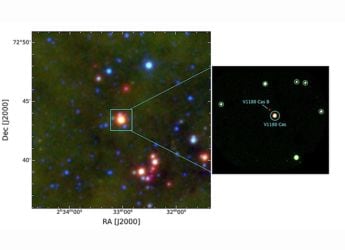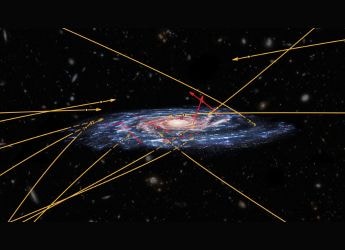- Home
- Science
- Science News
- Massive Asteroid 2002 JX8 to Fly Past Earth on May 9, Live Stream Available for Public Viewing
Massive Asteroid 2002 JX8 to Fly Past Earth on May 9, Live Stream Available for Public Viewing
On May 9, the asteroid 2002 JX8 will pass Earth safely and be available for live online viewing.

Photo Credit: Pixabay/BENG-ART
Watch asteroid 2002 JX8 fly by Earth safely via live stream on May 9
A massive asteroid nearly the size of a stadium will pass safely by Earth on May 9, and space enthusiasts can follow its journey in real time. The object, asteroid 612356 (2002 JX8), measures around 950 feet (290 metres) in diameter and is not a threat, as per NASA. The Virtual Telescope Project will broadcast the asteroid's flyby on its YouTube channel starting at 4:30 p.m. EDT (20:30 GMT). The asteroid is expected to make its closest approach at 11:02 GMT. The stream will also feature asteroid Vesta, which remains visible after reaching opposition on May 2.
Asteroid 2002 JX8's Safe Flyby Offers Stargazers a Rare Celestial Event
As per a recent post by Gianluca Masi, founder of The Virtual Telescope Project, it will come as close to Earth as a million kilometres (2.6 million miles) — 10.9 times the average distance between Earth and the Moon. The project provides free online observing opportunities in which exciting celestial phenomena, for example, asteroids changing position against the background of stars, can be brought to the attention of the public.
NASA had previously labelled 2002 JX8 as a potentially hazardous asteroid (PHA) due to its size and proximity during pass-bys, but has assured that there is no need for concern at this time. The PHA designation applies to any asteroid that's bigger than 140 meters that zips by Earth at a relatively close distance, less than 0.05 AU or about 4.6 million miles.
Near Earth Object tracking also does not predict an impact of a similarly sized asteroid for at least another century. NASA estimates that an asteroid with a 140-meter diameter may strike Earth every 20,000 years and one with a 1,000-meter diameter every 700,000 years.
The event is a great chance for visitors to examine objects like planets or star clusters with telescopes or binoculars and refer to guides to view the night sky.
Catch the latest from the Consumer Electronics Show on Gadgets 360, at our CES 2026 hub.
Related Stories
- Samsung Galaxy Unpacked 2025
- ChatGPT
- Redmi Note 14 Pro+
- iPhone 16
- Apple Vision Pro
- Oneplus 12
- OnePlus Nord CE 3 Lite 5G
- iPhone 13
- Xiaomi 14 Pro
- Oppo Find N3
- Tecno Spark Go (2023)
- Realme V30
- Best Phones Under 25000
- Samsung Galaxy S24 Series
- Cryptocurrency
- iQoo 12
- Samsung Galaxy S24 Ultra
- Giottus
- Samsung Galaxy Z Flip 5
- Apple 'Scary Fast'
- Housefull 5
- GoPro Hero 12 Black Review
- Invincible Season 2
- JioGlass
- HD Ready TV
- Laptop Under 50000
- Smartwatch Under 10000
- Latest Mobile Phones
- Compare Phones
- OPPO Reno 15 Pro Max
- Honor Win RT
- Honor Win
- Xiaomi 17 Ultra Leica Edition
- Xiaomi 17 Ultra
- Huawei Nova 15
- Huawei Nova 15 Pro
- Huawei Nova 15 Ultra
- Asus ProArt P16
- MacBook Pro 14-inch (M5, 2025)
- OPPO Pad Air 5
- Huawei MatePad 11.5 (2026)
- Xiaomi Watch 5
- Huawei Watch 10th Anniversary Edition
- Acerpure Nitro Z Series 100-inch QLED TV
- Samsung 43 Inch LED Ultra HD (4K) Smart TV (UA43UE81AFULXL)
- Asus ROG Ally
- Nintendo Switch Lite
- Haier 1.6 Ton 5 Star Inverter Split AC (HSU19G-MZAID5BN-INV)
- Haier 1.6 Ton 5 Star Inverter Split AC (HSU19G-MZAIM5BN-INV)
-
 AI Can Reportedly Take Away More Than 2 Lakh Banking Jobs by 2030
AI Can Reportedly Take Away More Than 2 Lakh Banking Jobs by 2030
-
 Astronomers Decode the Strange Behaviour of a Young Star 1,950 Light-Years Away
Astronomers Decode the Strange Behaviour of a Young Star 1,950 Light-Years Away
-
 Runaway Stars Help Astronomers Trace Dark Matter Distribution Across the Milky Way Galaxy
Runaway Stars Help Astronomers Trace Dark Matter Distribution Across the Milky Way Galaxy
-
 Poco M8 5G Confirmed to Feature 3D Curved Display and Snapdragon 6 Gen 3 Chip; Software Policy Announced
Poco M8 5G Confirmed to Feature 3D Curved Display and Snapdragon 6 Gen 3 Chip; Software Policy Announced












